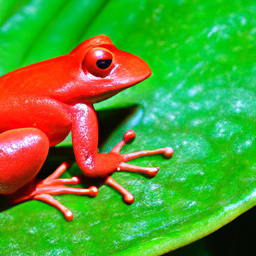|
--- |
|
license: creativeml-openrail-m |
|
tags: |
|
- text-to-image |
|
--- |
|
|
|
# Karlo v1 alpha |
|
|
|
Karlo is a text-conditional image generation model based on OpenAI's unCLIP architecture with the improvement over the standard super-resolution model from 64px to 256px, recovering high-frequency details only in the small number of denoising steps. |
|
|
|
* [Original codebase](https://github.com/kakaobrain/karlo) |
|
|
|
## Usage |
|
|
|
Karlo is available in diffusers! |
|
|
|
```python |
|
pip install diffusers transformers accelerate safetensors |
|
``` |
|
### Text to image |
|
|
|
```python |
|
from diffusers import UnCLIPPipeline |
|
import torch |
|
|
|
pipe = UnCLIPPipeline.from_pretrained("kakaobrain/karlo-v1-alpha", torch_dtype=torch.float16) |
|
pipe = pipe.to('cuda') |
|
|
|
prompt = "a high-resolution photograph of a big red frog on a green leaf." |
|
|
|
image = pipe([prompt]).images[0] |
|
|
|
image.save("./frog.png") |
|
``` |
|
|
|
 |
|
|
|
### Image variation |
|
|
|
```python |
|
from diffusers import UnCLIPImageVariationPipeline |
|
import torch |
|
from PIL import Image |
|
|
|
pipe = UnCLIPImageVariationPipeline.from_pretrained("kakaobrain/karlo-v1-alpha-image-variations", torch_dtype=torch.float16) |
|
pipe = pipe.to('cuda') |
|
|
|
image = Image.open("./frog.png") |
|
|
|
image = pipe(image).images[0] |
|
|
|
image.save("./frog-variation.png") |
|
``` |
|
|
|
 |
|
|
|
## Model Architecture |
|
|
|
### Overview |
|
Karlo is a text-conditional diffusion model based on unCLIP, composed of prior, decoder, and super-resolution modules. In this repository, we include the improved version of the standard super-resolution module for upscaling 64px to 256px only in 7 reverse steps, as illustrated in the figure below: |
|
|
|
<p float="left"> |
|
<img src="https://raw.githubusercontent.com/kakaobrain/karlo/main/assets/improved_sr_arch.jpg"/> |
|
</p> |
|
|
|
In specific, the standard SR module trained by DDPM objective upscales 64px to 256px in the first 6 denoising steps based on the respacing technique. Then, the additional fine-tuned SR module trained by [VQ-GAN](https://compvis.github.io/taming-transformers/)-style loss performs the final reverse step to recover high-frequency details. We observe that this approach is very effective to upscale the low-resolution in a small number of reverse steps. |
|
|
|
### Details |
|
We train all components from scratch on 115M image-text pairs including COYO-100M, CC3M, and CC12M. In the case of Prior and Decoder, we use ViT-L/14 provided by OpenAI’s [CLIP repository](https://github.com/openai/CLIP). Unlike the original implementation of unCLIP, we replace the trainable transformer in the decoder into the text encoder in ViT-L/14 for efficiency. In the case of the SR module, we first train the model using the DDPM objective in 1M steps, followed by additional 234K steps to fine-tune the additional component. The table below summarizes the important statistics of our components: |
|
|
|
| | Prior | Decoder | SR | |
|
|:------|----:|----:|----:| |
|
| CLIP | ViT-L/14 | ViT-L/14 | - | |
|
| #param | 1B | 900M | 700M + 700M | |
|
| #optimization steps | 1M | 1M | 1M + 0.2M | |
|
| #sampling steps | 25 | 50 (default), 25 (fast) | 7 | |
|
|Checkpoint links| [ViT-L-14](https://arena.kakaocdn.net/brainrepo/models/karlo-public/v1.0.0.alpha/096db1af569b284eb76b3881534822d9/ViT-L-14.pt), [ViT-L-14 stats](https://arena.kakaocdn.net/brainrepo/models/karlo-public/v1.0.0.alpha/0b62380a75e56f073e2844ab5199153d/ViT-L-14_stats.th), [model](https://arena.kakaocdn.net/brainrepo/models/karlo-public/v1.0.0.alpha/efdf6206d8ed593961593dc029a8affa/decoder-ckpt-step%3D01000000-of-01000000.ckpt) | [model](https://arena.kakaocdn.net/brainrepo/models/karlo-public/v1.0.0.alpha/85626483eaca9f581e2a78d31ff905ca/prior-ckpt-step%3D01000000-of-01000000.ckpt) | [model](https://arena.kakaocdn.net/brainrepo/models/karlo-public/v1.0.0.alpha/4226b831ae0279020d134281f3c31590/improved-sr-ckpt-step%3D1.2M.ckpt) | |
|
|
|
In the checkpoint links, ViT-L-14 is equivalent to the original version, but we include it for convenience. We also remark that ViT-L-14-stats is required to normalize the outputs of the prior module. |
|
|
|
### Evaluation |
|
We quantitatively measure the performance of Karlo-v1.0.alpha in the validation split of CC3M and MS-COCO. The table below presents CLIP-score and FID. To measure FID, we resize the image of the shorter side to 256px, followed by cropping it at the center. We set classifier-free guidance scales for prior and decoder to 4 and 8 in all cases. We observe that our model achieves reasonable performance even with 25 sampling steps of decoder. |
|
|
|
CC3M |
|
| Sampling step | CLIP-s (ViT-B/16) | FID (13k from val)| |
|
|:------|----:|----:| |
|
| Prior (25) + Decoder (25) + SR (7) | 0.3081 | 14.37 | |
|
| Prior (25) + Decoder (50) + SR (7) | 0.3086 | 13.95 | |
|
|
|
MS-COCO |
|
| Sampling step | CLIP-s (ViT-B/16) | FID (30k from val)| |
|
|:------|----:|----:| |
|
| Prior (25) + Decoder (25) + SR (7) | 0.3192 | 15.24 | |
|
| Prior (25) + Decoder (50) + SR (7) | 0.3192 | 14.43 | |
|
|
|
|
|
For more information, please refer to the upcoming technical report. |
|
|
|
### Training Details |
|
|
|
This alpha version of Karlo is trained on 115M image-text pairs, |
|
including [COYO](https://github.com/kakaobrain/coyo-dataset)-100M high-quality subset, CC3M, and CC12M. |
|
For those who are interested in a better version of Karlo trained on more large-scale high-quality datasets, |
|
please visit the landing page of our application [B^DISCOVER](https://bdiscover.kakaobrain.com/). |
|
|
|
## BibTex |
|
If you find this repository useful in your research, please cite: |
|
``` |
|
@misc{kakaobrain2022karlo-v1-alpha, |
|
title = {Karlo-v1.0.alpha on COYO-100M and CC15M}, |
|
author = {Donghoon Lee, Jiseob Kim, Jisu Choi, Jongmin Kim, Minwoo Byeon, Woonhyuk Baek and Saehoon Kim}, |
|
year = {2022}, |
|
howpublished = {\url{https://github.com/kakaobrain/karlo}}, |
|
} |
|
``` |